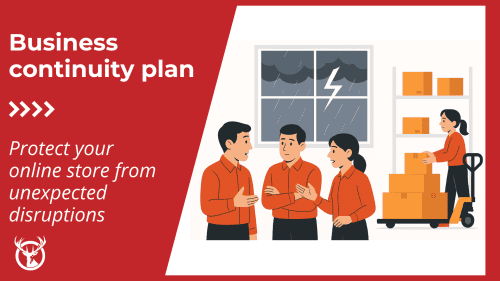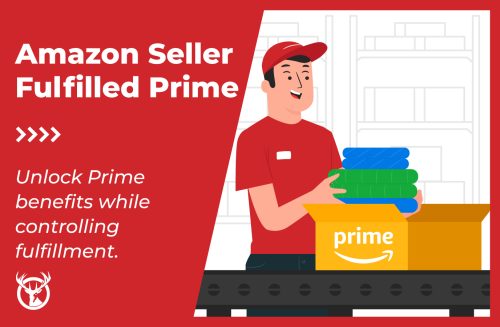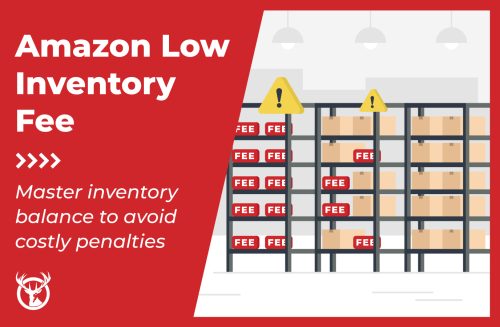It’s not often that logistics and inventory management approaches are ahead of the curve, but our space has been having the decentralized versus centralized inventory debate for decades. Blockchain and digital currencies are the prominent new voices in decentralization. However, it’s a conversation that entrepreneurs and operations leaders regularly have because, just like in finance, there’s no clear winner.
Those conversations on the latest cryptos and NFTs will be a good backdrop for our look at centralized inventory because it all comes down to control. Centralized efforts are easier to manage and control, but decentralized inventory management offers exciting benefits if you’re big enough to control that complexity. There’s no correct answer for everyone, but this will help you find a more intelligent answer for your business.

What is centralized inventory?
A centralized inventory management approach is where you keep all stock in a single location. Typically, this is central to business operations, such as being close to manufacturing spots or existing office space. Companies may also choose a location with access to multiple carriers and modes of transportation to make it easy to fulfill orders across the country.
Centralized inventory setups put all fulfillment functions in one location, making it easy to start and run a business. Goods arrive inbound to your location, you store them, and then use SKUs for pick and pack. The location has your dock doors, so goods leave close to where they arrived.
Pros and cons of centralized inventory
Centralized inventory management is all about simplicity in controlling fulfillment. You’re not worried about managing across locations, so there’s less risk of miscounting or misplacing your goods. For managers, you’re also only worried about hiring for a single location, keeping your workforce trim, and allowing leaders to retain more control. On the IT side, you’ve got access to more warehouse and inventory management tools because you don’t need modules that support multiple locations.
Cost control continues across all aspects of your operations. If you own the warehouse space, relying on one location is generally substantially cheaper than having multiple locations. Managing teams and relationships is more straightforward, so your HR and compliance teams work in fewer jurisdictions and can run the ship more quickly.
The downsides of centralized inventory management focus on increased costs around fulfillment activities, plus some slowing of processes. Generally, having a single fulfillment location means many of your orders will travel far across the country. These orders will take longer to reach customers at the coasts, and you’ll be paying a little more for each shipment because of the shipping zones they travel. You’re also limited to that specific region for talent, carriers, and warehouse space. If anything goes wrong here, your operation will halt because you’ve got no goods stored elsewhere for emergency use.
Pros
- Simplified control thanks to a single location
- Typically, less capital investment is required for startup and ongoing efforts
- Less complex fulfillment thanks to working with a single inventory
- Greater access to entry-level inventory and warehouse management tools
Cons
- Increased average shipping costs
- Potential for longer shipping times to major coastal markets
- Less diversity in carrier and service options, increasing risk
- Single point of failure in your fulfillment – increased liability of all goods being in a single location
- This can make it difficult to scale out of the “startup” phase as customers and channels scale

What is decentralized inventory?
Decentralized inventory management is a different approach that involves spreading your total inventory across multiple locations. These are typically far apart within the U.S., while each is close to different major markets. You may have facilities on each coast, or you may choose to have in the central U.S. for access to rail, air, and truck hubs.
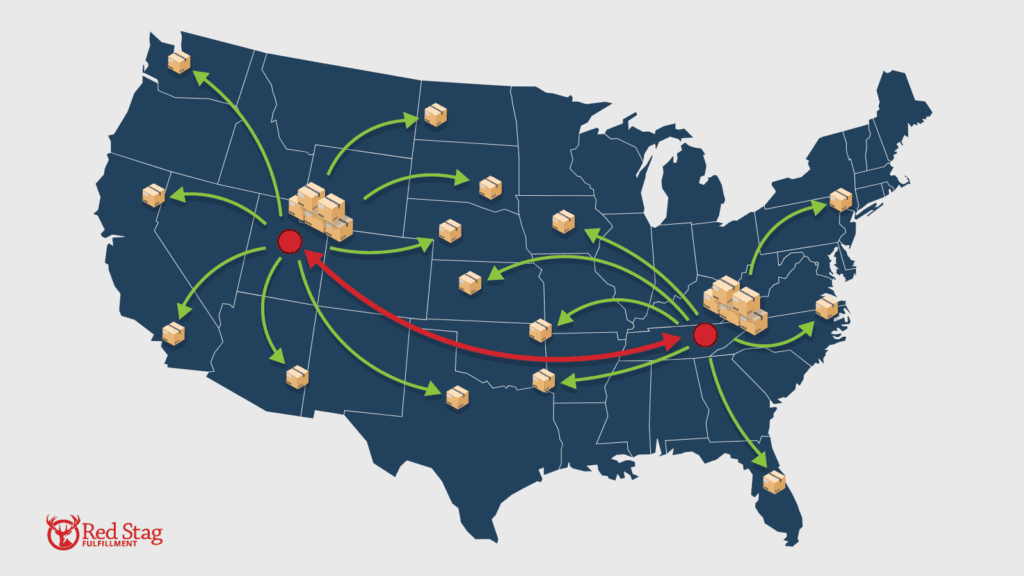
Pros and cons of decentralized inventory management
Distributing your inventory across multiple locations enables operations to be more flexible. You’re protected from localized disasters while you can choose to fill orders from the location closest to customers. This focus reduces last-mile costs for your orders, driving down the average price. That can often make up for any costs associated with getting inbound freight to multiple locations.
Decentralized setups tend to get goods to consumers faster at a lower parcel cost compared to centralized inventory management. However, the economics of this method requires a higher volume of orders to be helpful. You’ll need to offset the cost of more expensive systems that automatically manage orders across multiple locations. Typically, you’re also doubling your labor and personnel costs — each location needs its own warehouse workers, team leaders, HR professionals, and more. Rent, utilities, insurance, and other costs associated with physical space are higher — though a tradeoff means you can acquire a larger footprint overall.
Decentralized inventory approaches also may improve other customer-focused areas. You could improve your customer experience by delivering orders faster. Scaling up to multiple locations also comes with software improvements, so you may get a boost correlated with reduced pick and pack error rates. It’s a potential benefit despite an increased risk if your team doesn’t manage operations properly.
Getting the benefits of multiple locations while avoiding these pitfalls is why many companies choose a 3PL partner at this point.
Pros
- Faster last-mile delivery to customers while reducing last-mile costs
- Easier to win sales or move into product areas requiring faster turnaround or significant seasonality
- Less risk to inventory through multiple backup locations
- Increased chance to satisfy customers
- Easier expansion of products and reach
- Increased access to carriers, both regional and national partners
- Increased flexibility in fulfillment choice, such as shipping based on speed versus cost
Cons
- Higher inbound costs
- Increased labor, equipment, and space costs due to multiple locations
- Requires scale to optimize affordability
- Greater demands on non-fulfillment areas, such as HR and IT
- Requires more standardization of processes to ensure consistency across warehouses and locations

What’s the core difference between the two?
The chief difference between centralized and decentralized inventory is that you’re either focused on keeping operations simple and direct (centralized) or willing to have a more demanding setup with the potential to improve operations and control costs at scale (decentralized).
Many companies make this choice based on the challenges they face. A poor customer experience due to slow fulfillment or high-cost returns may be the push you need to expand from one to multiple locations. Shifting demographics may make new warehouse locations more profitable. But if you’re not scaling or have an incredibly complex fulfillment process, decentralization may introduce additional complications that harm profitability.
Your operational needs should guide the choice between decentralized and centralized inventory management.
Can a 3PL help you?
At Red Stag Fulfillment, many of the eCommerce companies we work with will focus on growing while improving customer service. That generally starts by making fulfillment more dependable. Reducing errors in pick and pack, minimizing returns, and eliminating shrinkage protect a company’s bottom line and their customers. From there, it gets easier to prioritize scaling.
We work with companies like yours to create an inventory plan designed to boost your operations how they are today. Then, we’ll work together on the way to help you reach new heights over the coming years. That can mean either a centralized or decentralized approach.
Red Stag offers Knoxville, TN, and Salt Lake City, UT, fulfillment locations. Our partners can use either or both as they see fit. We work to help each company understand where their inventory will be helpful. When there are advantages to splitting your inventory, we’ll walk you through those. Thankfully, by partnering with us, you’ll get access to multiple locations without many of the typical costs. We manage the workforce, warehouse leases, and other elements, while expenses are typically limited to just the inventory and orders you have.
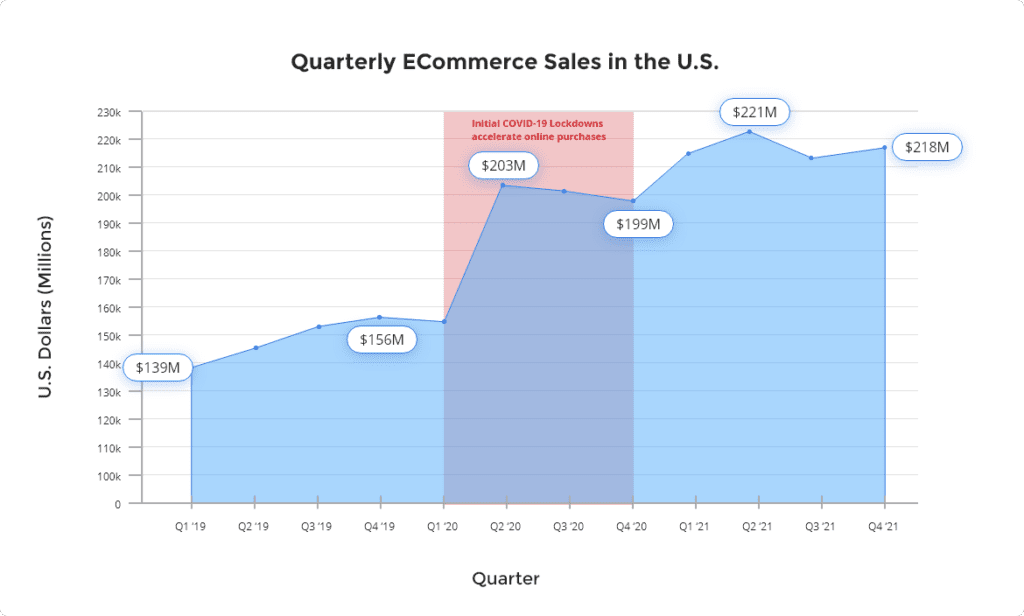
What if the market changes?
3PLs like Red Stag Fulfillment have existing warehouse space that makes it easy for your business to scale up or down as needed. Our warehouses and carrier partner network ensure available space to keep your goods or extra shelves to use when sales climb. By collaborating with multiple carriers at each location, we can also help you control last-mile costs.
You’ll get access to our dashboard, which shows current inventories, orders, and usage data. That means you can update inventory and stock levels as soon as your market moves in either direction. That’s true for centralized inventory and decentralized configurations. (A bonus for your operations and customer service team here is that this integration with our system also ensures they can access shipment-level data at any moment. So, when a customer calls you to track an order, your team can respond immediately. There’s no need to make the customer wait.)
The ongoing pandemic has taught companies with large supply chains and partners like us that everything can change in a moment. So, we’re paying attention to the market and what it may mean for our partners. Check out this recent look at freight rates to see what we’re tracking. Our goal is to help you protect and grow your operations, so we aim to be a partner for whatever comes next.
How does Red Stag support its partners?
The Red Stag approach is that we aim to give you the tools and space needed to expand your business. That means everything from guaranteeing fulfillment quality and reliability to regularly building out new warehouse locations to ensure we’re adding square footage. We’ll help you find multiple carriers to protect against outages and start shoring up capacity for the year-end crunch.
We work with you to create a plan and help you execute it. However, the big decisions are under your control. Choose a decentralized or centralized inventory. Select the warehouse location(s) you prefer. Pick your carriers and the fine details around fulfillment products and even custom boxes and tape. Then, Red Stag takes over the heavy lifting of your fulfillment so you can get back to focusing on the sales you love.







